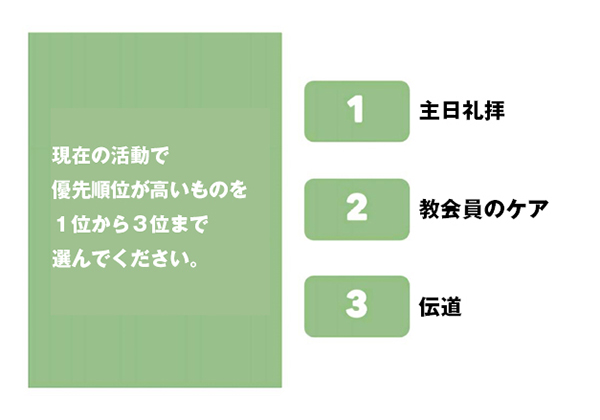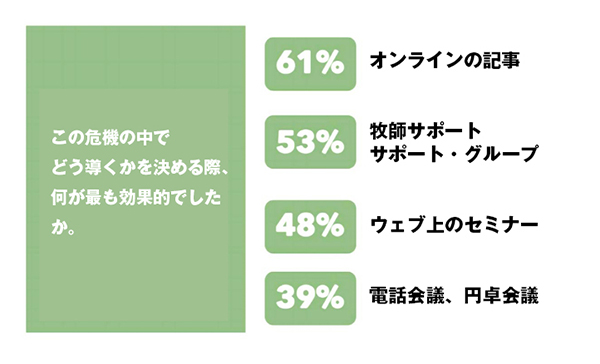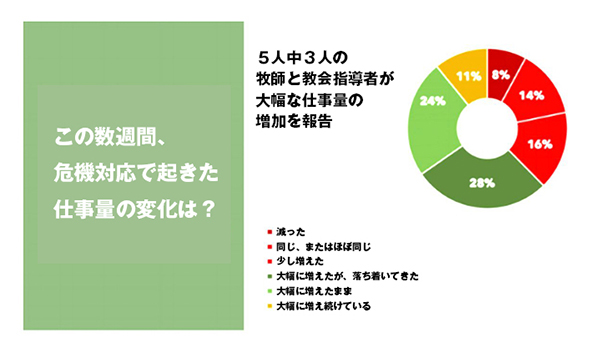3 日曜礼拝と教会員のケアが引き続き優先事項の上位に
Third, Sunday services and church members continue to be leading priorities.
この危機に際して、牧師と教会指導者にとっての困難は、やるべきことの優先順位をつけて活動を減らすことだ。オンライン礼拝への対応は早急に進んだが、「社会的孤立」という新しい現実に適応する、それ以外の活動はゆっくりと進化している。
One of the main struggles for pastors and church leaders in this crisis is to narrow and refine their ministry priorities. The rush to move services online has been followed by a slow evolution in the rest of church ministries and outreach to adapt to the new socially isolated reality.
だから、牧師と教会指導者に現在の優先事項のトップ3を挙げてもらうと、「主日礼拝」と「教会員のケア」が突出(30%と29%)し、「伝道」はその後(18%)になった。これ以外で6%を超える優先事項はなかった。
Thus, when we asked pastors and church leaders to rank their three top current priorities, the weekend service and church membership care were the far most common top priority (30 percent and 29 percent respectively) followed by evangelism (18 percent). No other selection registered above six percent as a top priority.
優先事項の1位と2位を見ると、「主日礼拝」を選んだのが牧師と教会指導者の54%、「教会員のケア」が48%、「伝道」としたのは29%だった。言い換えれば、リモートで活動する現在、この3つが牧師と教会指導者にとって重要な活動なのだ。
When accounting for either a first or second priority, 48 percent of pastors or church leaders selected weekend services, 54 percent selected church membership care, and 29 selected evangelism. In other words, these three ministry areas are the leading priorities among pastors and church leaders during this season of remote ministry.

牧師と教会指導者は日曜礼拝を最優先事項としているが、社会的距離を取らなくてはいけないというルールのもとで、どう地域の人々とつながることができるか、模索も続けている。調査では、「この困難な時に、教会、スタッフ、団体を指導するために必要な支援は何ですか」と質問した。
While pastors and church leaders are prioritizing Sunday services, they continue to look for help in how to engage their people and communities despite social distancing restrictions. The survey asked, “What kinds of resources do you need to lead your church, staff, or organization in this challenging time?”
上位の二つに挙げられた回答は、「オンラインで会話や集会をする」(61%)、「困難な時でも宣教をするための実用的なやり方」(55%)だった。つまり、ここ数週間、教会は、集会や伝道のために革新的にならざるを得なかったのだが、牧師と教会指導者は「まだ改善の余地がある」と前向きな姿勢を持っているということだ。
The top two answers remained how to create engaging online conversations and gatherings (61 percent) and practical ways to be on mission in this season (55 percent). Thus, even as churches have had several weeks to innovate in their gatherings and outreach, pastors and church leaders are still highly motivated to improve.
〈今後の焦点〉
伝道と弟子訓練のための枠組みである、アップ(礼拝)、イン(互いのために行動する)、アウト(伝道と愛)は多くの教会でおなじみだろう。最初の数週間は、この新しい規則の中でアップとインのリズムをつかむために努力する重要な期間だった。受難週の間、多くの人がアウト活動をする中で、教会につながっていない人の間で霊的関心が高まっていることが分かった。
Many churches are familiar with the UP (worship), IN (practicing “one anothers”), and OUT (evangelism and mercy) framework for ministry and discipleship. These first weeks were a significant effort to develop the UP and IN rhythms in this new norm. During Holy Week, many discovered through their OUT engagement that the unchurched have a unique spiritual interest right now.
受難週の後も、春と夏を迎えるまで、言葉だけでなく行いによってこのアウトの状態を保つ努力を続けるのは価値あることだ。マイク・フロストの『今、隣人を愛するための35の方法』のリストやエド・ステッツァーの『新型コロナ・ウイルス時の伝道』、リック・リチャードソンの『新型コロナ・ウイルス時の証し』を参考にしてほしい。
It is a worthwhile effort for you to keep the OUT posture from Holy Week into the spring and summer months, both in word and in deed. See Mike Frost’s list of 35 Ways to Love Your Neighbors Right Now, Ed Stetzer’s “Evangelism in the Time of Coronavirus,” and Rick Richardson’s “Witness in the Time of the Coronavirus.”
4 教会指導者の求める重要なものは共同のプラットホーム
Fourth, collaborative platforms are emerging as critical resources sought by church leaders.
牧師と教会指導者に「この危機の中でどう導くかを決める際、何が最も効果的だったか」と聞いたところ、「オンラインの記事」(61%)が最も多かった。
When we asked pastors and church leaders what modes of resources have been most effective in deciding how to lead through the crisis, the online articles (61 percent) was the most common answer.

しかしながら、牧師と教会指導者の間では、効果的なフォーマットとして、地域に根差した学びが強調された。牧師サポート、サポート・グループ(53%)、ウェブ上のセミナー(48%)、電話会議、円卓会議(39%)がそれに続く3つの回答で、牧師と教会指導者が単にメディアの情報を得るよりも、ほかの指導者と疑問やアイデアを交わしたいと願っていることがうかがえる。これは、「オンラインの学び」(12%)や「ニュースレター」(11%)の数値が低いことからも分かる。
However, there is a discernable emphasis upon community based learning among pastors and church leaders as effective formats. Pastor cohorts/regular support groups (53 percent), webinars (48 percent), and conference calls/roundtables (39 percent) were the next three responses, signaling a desire among pastors and church leaders to engage other leaders with their questions and ideas rather than strictly consume media. This is further reflected in the low response to online courses (12 percent) and newsletters (11 percent).
さらに、そのようなコンテンツを作成する側は、牧師と教会指導者が「コンテンツの多さに辟易(へきえき)としている」と報告していることを知るべきだ。「情報過多だと感じるか」という設問に対して、「とてもそう思う」が19%、「そう思う」が42%で、「そう思わない」はたったの10%しかなかった。
Moreover, content producers should be warned that pastors and church leaders overwhelmingly report an oversaturation with the level of content for church leaders. Nineteen percent of respondents strongly agreed while 42 percent somewhat agreed that they were feeling oversaturated compared to only 10 percent that disagreed to any extent.
オンラインへの転換が、新しいメディアの大氾濫を生み、牧師は自分たちの優先事項にそぐうコンテンツを見つけるため、相当な量の情報から選び出す苦労をしているかもしれない。
As the shift to online has produced a deluge of new media, pastors may be struggling to sort through the mass to find the content relevant to their priorities.
〈今後の焦点〉
牧師と教会指導者は、良質な情報と支援を求めている。ネットワークのリーダーであれば、このパンデミックをどうやって導き抜くか、意図的な戦略を考えるための牧師サポートを開発すべきだろう。
Pastors and church leaders are looking for good information and support systems. If you are a network leader, it’s not too late to develop pastoral cohorts to think through an intentional strategy for how to lead through and out of the pandemic.
これは牧師と教会指導者にとって、長期的な変革を行う重要な機会であり、教会員の働きや伝道活動といった働きを分散化させる。この危機のただ中で牧師サポートを建て上げることについては、カタパルト・グループから学んでほしい。
This is a vital opportunity for pastors and church leaders to make long lasting changes that will further decentralize ministry work in the direction of member mobilization and missional engagement. You can learn more from Catapult Group about designing pastoral cohorts in the midst of this crisis: wearecatapult.org/6weekcoachinggroups.
5 教会指導者は仕事量が大幅に増えているものの、自らの精神状態についてはおおむね楽観的
Finally, church leaders are generally positive about their mental state despite significant workload increases.
この危機が牧師と教会指導者の仕事量を大幅に増やしたことは想像にかたくない。今までの教会の運営法を根本的に見直して組織を導くだけでなく、前例のない恐怖、喪失、孤立の時に人々のケアをするという任務を牧師と教会指導者は担っているのだ。
This crisis has predictably resulted in a significant increase in workload for pastors and church leaders. As the burden to not only lead their organizations through a fundamental reorientation of how they operate, pastors and church leaders are also tasked with caring for their people during an unprecedented season of fear, loss, and isolation.
結果として、「仕事量が大幅に増えた」と報告したのは5人中3人以上の牧師と教会指導者、「ここ数週間で増えた」としたのは11%だった。多くの人が「この仕事量の増加は減り始めている」(28%)としているが、どのようにして新たな心の平安が築かれるのか、また牧師と教会指導者が過去数カ月で消費したエネルギーを補うことができるのかは明らかではない。
As a result, more than three of every five pastors and church leaders report a significant increase in their workload with 11 percent stating that it has only continued to grow in recent weeks. While the largest block report that this workload is beginning to slow (28 percent), it is not clear what new equilibrium will be established nor whether pastors and church leaders are going to be able to recuperate from the energy expended over the past month.

仕事の増加があったにもかかわらず、牧師と教会指導者は自らの精神状態を前向きにとらえている。トップ3の回答は「希望がある」46%、「励まされている」38%、「回復できる」33%と楽観的で、現在の危機の中でも牧師と教会指導者は教会や地域で実を結ぶことができるように努めていることが分かる。
Despite this increase, pastors and church leaders are optimistic in describing their mental state. The three most common answers (Hopeful – 46 percent; Encouraged – 38 percent; and Resilient – 33 percent) are positive and speak to the attitude many pastors and church leaders have to the possibility for this crisis to bear fruit in their churches and communities despite it’s the current challenges.
対照的に、否定的な回答を選んだ牧師と教会指導者は、燃え尽き症候群に見られる状態、つまり「孤独」(4%)や「困難」(7%)を選んだ。しかしながら、上位二つの回答である「疲れ」(21%)と「分からない」(20%)が示すのは、牧師と教会指導者がおおむね楽観視しているにもかかわらず、この危機が牧師の健康状態に影響を与えているということだ。
In contrast, few pastors and church leaders selected the negative attributes commonly associated with burnout such as Lonely (four percent) or Struggling (seven percent). It is important to note, however, that the two leading negative attributes, Exhausted (21 percent) and Uncertain (20 percent) reflect the toll this season has had upon pastoral health even as they remain generally positive.
この緊張状態は多くの回答に表れている。彼らは決心や集中といった前向きな要素によって、迅速に疲れを追いやっている。
This tension was reflected in the qualitative answers as many pastors and church leaders remarked that they were tired but were quick to temper this admission with a positive attribute such as determined or focused.
この負担を予想して、この危機の中でリーダーシップを取るために役立ったものは何か、そのトップ3を牧師と教会指導者に聞いた。オンラインのコミュニティーやフェローシップが広く受け入れられているにもかかわらず、多くの人が共通して答えたのが教会の人間関係だ。そして「教会スタッフと指導者の支援」が68%、「教会員の支援」が41%だった。
Anticipating this burden, we asked pastors and church leaders what top three sources have been the most helpful to them as they lead through this crisis. Despite the widespread online communities and fellowships, many of the most common responses emphasized local relationships within the congregation with over two thirds (68 percent) selecting support from church staff and leaders and 41 percent citing support from church members.
「教団や教会ネットワーク」(41%)と「他教会の手助け」(33%)が後に続いた。「政府の手立て」(19%)と「教会以外の団体」(16%)が低かったのは、先の見えない中で牧師と教会指導者が目を向けたのは、息の長い信頼の置ける関係性だったことを示している。
These were followed by resources from denomination/church networks (41 percent) and resources from other churches (33 percent). That governmental sources (19 percent) and resources from non-church ministries (16 percent) were the lowest responses may signal that in times of uncertainty, pastors and church leaders are turning to networks and sources with whom they have longstanding trust and relationship.
〈今後の焦点〉
短距離走だと思っていたのに、長距離走になってしまった。持続可能ではないペースで働き続ける牧師と教会指導者には、自らと組織のために長期にわたって持続可能な場所を作り始める必要がある。自らのケアと魂のケアについて話し、実際に行うことが重要になっている。その必要性は今まで以上に高い。
What started as a sprint has turned into a marathon. Pastors and church leaders who are continuing at an unsustainable pace are needing to begin to make place for long term sustainability both for their organizations and themselves. This means that conversations and practices around self-care and soul care are vital perhaps more vital than ever.
この危機に対応して1カ月以上が経った今、重要なことは、皆さんが、またその家族や指導者が、新しい働きのリズムを身につけることだ。このパンデミックが終わった後にも続けられるような健康的なリズムを。私たちは評判の良いグループとパートナーシップを結び、この危機に際して牧師と教会指導者が健康に目を向けるための資料を用意した。
More than a month into responding to the crisis, it is essential that you, your family, and your leaders find a new normal rhythm for ministry. Especially one that is healthy enough to want to keep after the pandemic is over. We have partnered with many other reputable groups to develop resources for pastors and leaders to focus on their own health during this time: resilientchurchleadership.com.
結 論
この世と同じで、教会のリーダーシップも流動的だ。どうすればこの危機に際して最善の対応ができるのか、大きな疑問が次々とわいてくる。経済的に献金額が減る中で、牧師と教会指導者は前向きだ。しかしながら、献金が減り続けば、それも変わるだろう。
Like much of the world, church leadership is in flux. There are significant and ongoing questions about how best to respond. As financial giving is trending down, pastors and church leaders have remained positive. However, if downward trends continue, that will probably change.
いくつかの点で、牧師と教会指導者が自らの働きと教会員をこの状況に見事に適応させたことがデータから見えてくる。同時に、もっと効果的に教会員を養い、地域に仕える方法を探求したいという強い衝動も残っている。
In some ways, the data shows that pastors and church leaders have successfully adapted their ministries and people to the situation. At the same time, there remains a strong impulse to search for more innovative and effective ways to nurture congregations and engage communities.
この必要性は、再出発の問題が優先されるようになると、牧師と教会指導者に大きな負担をかけ続けることになる。だからこそ牧師と教会指導者は、伝道と休息の健康的なリズムを身につけることが今まで以上に大切だ。このような前例のない危機の中で効果的な働きをするために、牧師の成長とリフレッシュに役立つものやコミュニティーを探し続けることは大きな助けになるだろう。
This need will only continue to place major burdens on pastors and church leaders as questions of reemergence begin to take precedence. Thus, it is more important than ever in the coming weeks for leaders to develop healthy rhythms of ministry and rest. This would be greatly aided by the continued seeking out of ongoing resources and communities that equip and refresh pastors to meet the demands of effective ministry during such an unprecedented season.
アンドリュー・マクドナルド、エド・ステッツァー、トッド・ウィルソン、ダニエル・ヤンによる報告
本記事は「クリスチャニティー・トゥデイ」(米国)より翻訳、転載しました。翻訳にあたって、多少の省略をしています。
出典URL:https://www.christianitytoday.com/edstetzer/2020/april/how-church-leaders-are-responding-to-challenges-of-covid-19.html
「クリスチャニティー・トゥデイ」(Christianity Today)は、1956年に伝道者ビリー・グラハムと編集長カール・ヘンリーにより創刊された、クリスチャンのための定期刊行物。96年、ウェブサイトが開設されて記事掲載が始められた。雑誌は今、500万以上のクリスチャン指導者に毎月届けられ、オンラインの購読者は1000万に上る。
関連





























